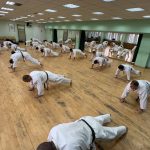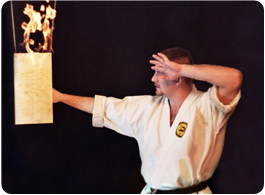I would like to present our beginners program. We do not work with children, so this program is designed for adults. After brief introduction training, where they learn basic positions (age, gedan, uchi, soto), stances and terminology, we proceed to this basic self-defense curriculum. Since, we implemented this program for adults our student retention ratio is much higher. Obviously adults join with goal to learn some practical stuff as soon as it is possible. They don’t want to practice oi-tsuki/kiba-dachi for months. So, give them what they want to learn and you will later have a chance to present more sophisticated side of tradition.
 1. tsuki
1. tsuki
First learn how to use your fist. This is easiest. Always aim at opponents nose. It is not necessary to deliver most powerful punch in your life, too much power will only make you miss your target. Use direct (not roundhouse), quick and precise punch. Use kake-uke (parry and grab) block to catch opponents arm and then pull him in to make your punch more devastating. Use natural stance shizen-dachi.
 2. kinteki geri
2. kinteki geri
Slide to the side (tenshin), away from opponents punch (neko ashi dachi) and grab his arm (kake uke). From this position kick to the opponent’s groin is logical choice. Use your front leg and do not try to put too much force into this movement. Kinteki geri is based on whipping motion. Forget those high, roundhouses and spinning kicks, they are not practical.
 3. hiza geri
3. hiza geri
Picture here shows knees kick to opponent head, but knee to groin is more usual choice. This technique is good defense against opponent who tries to grab/push you with both hands. Stand normally in shizen-dachi and when opponent is close enough burst into crane stance (tsuru-dachi). Block both opponents arms with your forearms and smash his testicles with your knee.
 4. empi uchi
4. empi uchi
Elbow techniques are very powerful and effective in close distance situations. You must use your whole body mass to make then effective, so slide in (irikumi) into horse stance (kiba-dachi) and struck with tremendous mass. Usual mistake is to use your whole forearm and to hit opponent’s chest muscles. Use the tip of your elbow (olecranon) to spear opponent’s ribs. Use your other hand as support.
 5. ushiro empi
5. ushiro empi
Sudden grab from behind is very realistic situation. Use you elbow escape. From natural stance, jerk and slide quickly to neko-dachi and deliver elbow smash, using your whole body mass.
 6. sagurite
6. sagurite
Your opponent is usually stronger then you and you have to choose very carefully what you will do, because you may not have other chance. Eye poke (sagurite) is really effective and simple technique. You don’t need mass and power for this technique. Evade opponent’s attack (tenshin), parry with your rear hand and whip-poke his eyes with fingers (nukki) of your front hand.
 7. shuto uchi
7. shuto uchi
Knife hand (shuto) is one of the most devastating weapons of karate. When delivered into opponent’s throat, it can be fatal. Also, shuto is used for blocking of opponents roundhouse punch. Okinawan folk tales testify that knife hand block can break arm bones. Point here is to surprise your opponent. Parry opponent’s attack and slide in cutting opponents neck with your shuto. First slide with your front foot (irikumi) and follow with your rear foot (assuming position known as cross-stance (kosa-dachi).
 8. yama uke
8. yama uke
Yama uke… beautiful name, “mountain block”. This position from kata Passai is used to catch attacker’s kick. You have to be firm as a mountain in front-stance (zen kutsu dachi). Use your front arm to scoop (sukui) opponent’s leg and grab opponents shoulder with your rear hand. It is important to place your rear arm in upper block (age uke) position, so that you are covered from opponents counterattack. You have to slide in (irikumi), grab and take him down with knee scoop of his standing leg.
 9. fumi kiri
9. fumi kiri
This very basic throw is called osoto-gari in judo. It is probably simplest way to throw your opponent on the ground. In many old okinawan katas this technique is hidden with mae geri. Fumi kiri is executed with leg returning part of the motion of mae geri. You will use your calf to kick out his leg.
 10. otoshi uchi
10. otoshi uchi
Elbow lock is used by many law enforcement officers throughout history as subduing technique. This is application is often hidden in kata and appears as gedan barai. Grab opponent’s wrist and press his elbow joint. You have to use a lot of power with this technique. Don’t press his elbow with your hand, instead grab cloth on his upper arm and press with your forearm.
 11. kubiwa
11. kubiwa
There are many variants of this technique, which is also known as shime in judo. You can use this to control, choke or take down your opponent. This technique is hidden in kata as upper cross block (juji-uke). I will describe here my favorite variant that appears in kata Kushanku. Evade opponent’s attack to the outer side and grab his arm. Quickly grab his hair with your other hand, step behind him and choke him.
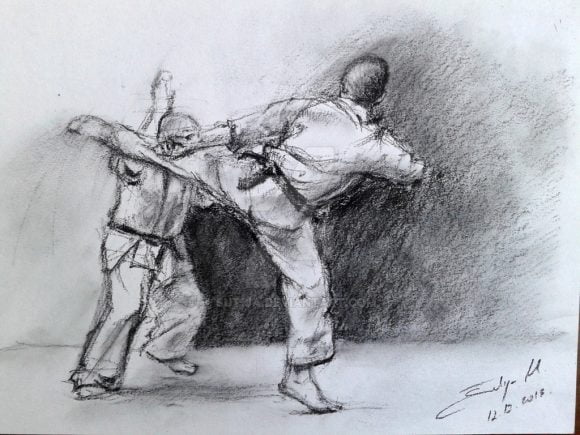
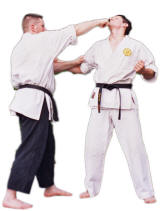 1. tsuki
1. tsuki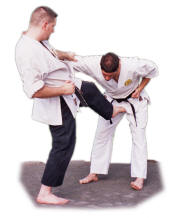 2. kinteki geri
2. kinteki geri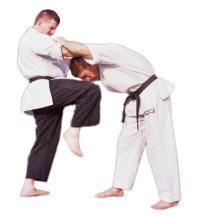 3. hiza geri
3. hiza geri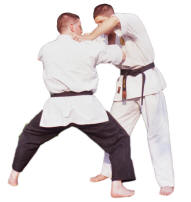 4. empi uchi
4. empi uchi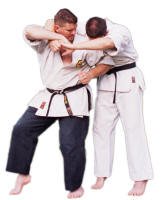 5. ushiro empi
5. ushiro empi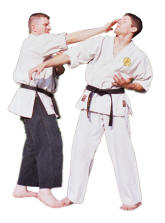 6. sagurite
6. sagurite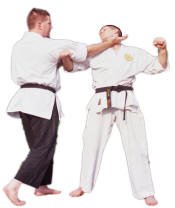 7. shuto uchi
7. shuto uchi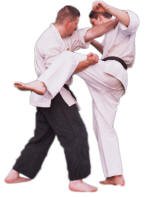 8. yama uke
8. yama uke 9. fumi kiri
9. fumi kiri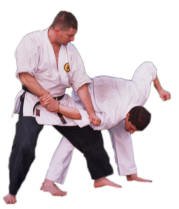 10. otoshi uchi
10. otoshi uchi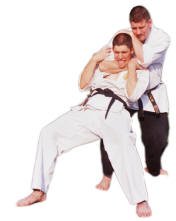 11. kubiwa
11. kubiwa